Aquarium
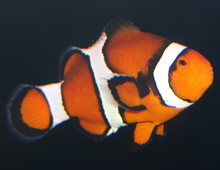
Percula clownfish, Amphiprion percula
The Percula clownfish , also known as the Orange clownfish, is a popular aquarium species, frequently bred in aquaculture facilities. It is naturally found throughout the Indo-Pacific and is generally associated with a host sea anemone such as Heteractis spp. The Percula clownfish is often confused with another similar species, the Ocellated clownfish, Amphiprion ocellaris. The Percula clown has thicker black bands separating the orange and white coloration on its body. It surged in popularity following the Disney/Pixar movie “Finding Nemo”, where it was featured as the lead characters, “Nemo” and “Marlin”.
LEARN MORE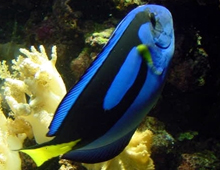
Blue hippo tang, Paracanthurus hepatus
The Blue hippo tang, also known as the Palette tang, or Hepatus tang, is a popular member of the Acathuridae family. This omnivorous fish can be found in small schools throughout the Indo-Pacific region and was made famous when featured as the character “Dory” in the Disney / Pixar movie, “Finding Nemo”. Like other members of the surgeonfish family, the Blue hippo tang is armed with a sharp spine at the base of its tail. This species, however, has an added weapon in the fact that the spine is armed with a venom gland, which can inflict a bee-like sting to its victim.
LEARN MORE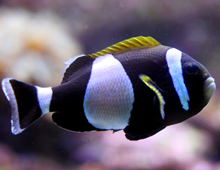
Wideband anemonefish, Amphiprion latezonatus
The Wideband anemonefish differs from its other clownfish relatives in the fact that it has a large white band in the center of its body. Like the McCullochi clownfish, the Latezonatus clownfish has only recently become available to aquarium hobbyists due to unprecedented success by marine aquaculturists. The natural range of the Wideband anemonefish extends from Southern Queensland to Northern New South Wales and Lord Howe Island.
LEARN MORE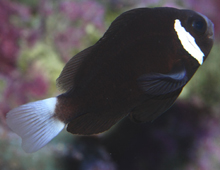
McCullochi clownfish, Amphiprion mccullochi
Once rarely displayed in public aquariums, the McCullochi clownfish has recently become available to aquarium hobbyists around the world. Like other species of clownfish, the McCullochi clownfish lays a patch of bright orange eggs at regular intervals, usually in close proximity to its host anemone. Both parents care for the developing embryos and can be seen carefully tending the eggs and fiercely protecting them from potential predators.
LEARN MORE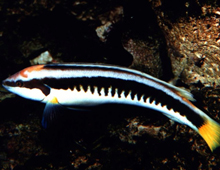
Comb wrasse, Coris picta
Comb wrasses are named for the comb-like markings on their side. These fish are rarely displayed in public aquariums. The DWA has displayed this species since 1994. This sub tropical fish can be found in coastal waters of Southeastern Australia, Lord Howe Island, and New South Wales. It feeds on small crabs and shrimp and the juveniles may clean other fishes.
LEARN MORE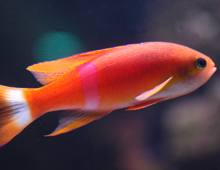
Painted goldie anthias, Psuedanthias pictilis
The Painted goldie anthias, also known as the Pictilis anthias, like other members of the sea bass family, are hermaphrodites. The brightly colored males can be seen battling for their harem of less colorful females. In the absence of a male, the most dominant female can become a male. Painted goldies feed on zooplankton and floating algae and often hide in crevices or caves in the reef.
LEARN MORE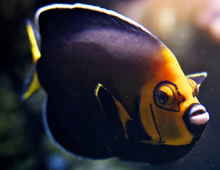
Spectacled angelfish, Chaetodontoplus conspicillatus
The DWA’s collection of coral reef fishes is internationally recognized for rarely-exhibited species. Marine angelfish (not to be confused with freshwater angelfish, which are cichlids) are a specialty and the Spectacled angelfish, also known as the Conspiculatus angelfish because of the “spectacle-like” rings around its eyes, is one of the most admired. This fish is found in the subtropical waters of Lord Howe Island and is considered rare in the aquarium industry. In 1994, the DWA was the first aquarium in the world to feature a Lord Howe Island exhibit.
LEARN MORE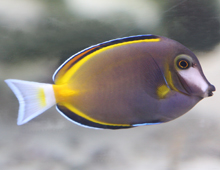
Powder-brown tang, Acanthurus japonicus
Although a vast number of saltwater fishes flourish in Asian waters, relatively few are restricted to them, otherwise being found also in Australia, East Africa, Hawaii, and other parts of the Pacific and Indian Oceans. Found only from the island of Sulawesi and the Philippines, north to Okinawa and Southern Japan, the Powder-brown or White-faced tang is truly an Asian fish. It can be mistaken for the more widespread, but harder to keep, Gold-rimmed tang A. nigricans, which has less white on its face.
LEARN MORE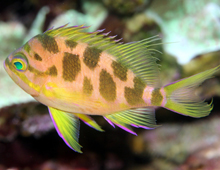
Blotchy anthias, Odontanthias borbonius
This fairy basslet is very rare in American aquariums, because it is normally found at depths of 600 to 900 feet, so is difficult and dangerous to collect. It has a wide range, from South Africa (where it lives with Coelacanths!) to Japan and the Palau Islands. It commonly swims upside down, beneath rock formations.
LEARN MORE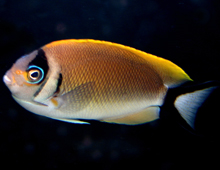
Japanese swallowtail angelfish, Genicanthus semifasciatus
The males and females of all swallowtail angels differ in color, but in this case, the difference is so extreme that the male was given the species’ scientific name in 1934, while the female was described as “Holacanthus fuscosus” in 1970. Only aquarium observations confirmed they were the same species. In Japan, this species is found only in Okinawa and “The Seven Islands of Izu” (of which there are actually around a dozen). It is also found off Taiwan and the Philippines.
LEARN MORE

